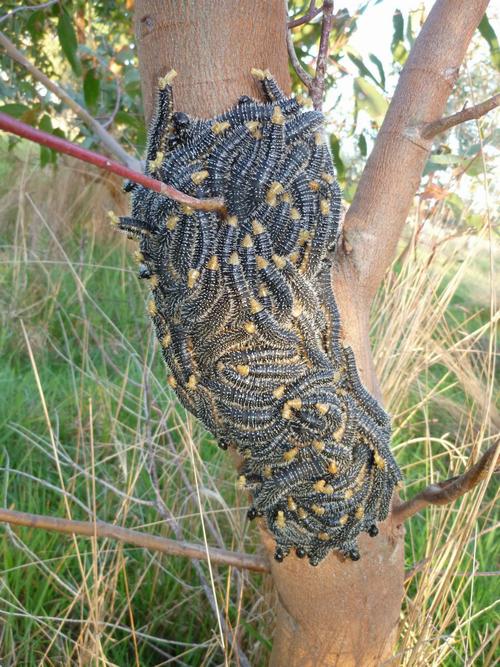Many animal societies have “despotic” leadership models, meaning that the leaders dominate the followers. You see this in societies such as wolves, etc. Perga affinis, a type of insect common in Australia (often called a “spitfire” or “sawfly”) may be bucking this trend.
The spitfires work as a group to forage nocturnally; they can basically strip the leaves from a tree in a matter of days, as you see in this photo here.
Spitfires work democratically, though — the leaders and the followers basically co-decide on the movements of the group.
Here’s maybe the most interesting aspect: in most animal societies, the leaders tend to be the larger, bigger, stronger animals — in part because, during the foraging/food finding process, they can get more (the rich get richer, you know?). But in these spitfire communities, there’s no difference in the weight/sizing of the “leaders” and the “followers.” It’s essentially a totally egalitarian world of stripping leaves from trees.
Now, let’s be upfront and clear about something: these are insects on seven-month larva cycles that live in Australia. We shouldn’t necessarily extrapolate anything about them to the broader world, as that would be kind of a train wreck. But still —
Think about this for a second.
It’s entirely possible that your office is designed around a core set of leaders — the SVP level or the C-Suite or whatever it’s called internally — and that level tends to get fatter and happier in terms of salary, perks, opportunities (and yes, also stress and challenges) while the middle and lower levels are stressed, challenged, busy and/or disengaged. You can argue with my broad generalizations here and you’d be right to do so, as every org is pretty different, but the engagement numbers in America are what they are for a reason.
But if you were to channel these larva and have leaders and followers essentially co-decide things — thus removing a level of hierarchy — maybe everyone could be better off.
Obviously this is a bit ridiculous — people need hierarchy because hierarchy provides structure, and people need leaders because leaders provide guidance and people need leadership roles because some people want something to aspire to. These are not necessarily the same thought processes of Australian bugs.
I think about a lot of different jobs that I’ve had over time. I usually feel pretty disconnected from top management (granted, I’ve never even been in middle management). I usually feel like I’m not really that well utilized. That goes both ways, of course — I could try harder to prove my value, and often I don’t/haven’t — but I think a major disconnect is in the leader-follower split. Leaders tend to spend time (perhaps too much time) with other leaders, which is why simply walking around more (and talking to your people) can make you a better leader — i.e. you’re not just spending time with your colleagues at the high level.
The broader point is this: when leaders and followers work together, everyone is well-fed and happy — as opposed to just a few people. Maybe we should learn more from Australian bugs, you know?

Reblogged this on Gr8fullsoul.